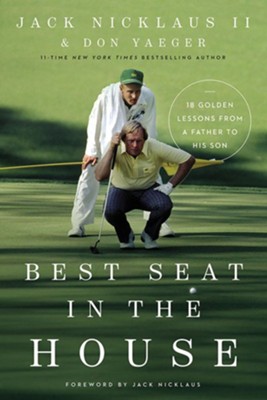Book Reviews: Aug/Sept 2021
Ever wonder what it’s like being the eldest son of the greatest golfer of all time and carrying his name as well? Jack (Jackie) Nicklaus II has had to bear that responsibility -- or perhaps burden  -- for more than 60 years. Now he has penned a revealing memoir where he shares his dad's greatest moments on the golf course and presents a series of 18 life lessons handed down to him and his siblings.
-- for more than 60 years. Now he has penned a revealing memoir where he shares his dad's greatest moments on the golf course and presents a series of 18 life lessons handed down to him and his siblings.
Best Seat in the House by Jack Nicklaus II and Don Yaeger (Thomas Nelson, $25.99) recaps the Golden Bear's major victories as seen through the eyes of a son who learned the game at his father's feet, as well as being an occasional caddie for Jack, most famously at the 1986 Masters. Jackie surrounds these victories with life lessons expounded by his father and mother that he claims shaped how he lives his life and how he treats people.
One of five children born to Jack and Barbara, he now has five of his own and raises them with these same principles. As a young adult, he played golf at the University of North Carolina, and while he was there he won the 1985 North & South Men's Amateur Championship. He spent a number of undistinguished years on professional tours around the world, and is now a golf course architect and a principal in Nicklaus Design.
Growing up, he also had the advantage of being around his dad's famous competitors including Arnold Palmer, Gary Player, and Billy Casper, all of whom Jack highly respected and admired. Jackie speaks to how influential they and others were in Jack's career, and the teachings they also imparted to Jackie and his brothers and sister.
He highlights one event that typifies his father's deep conviction on how to lead your life as a champion. Known as "The Concession," it has linked Jack Nicklaus forever with former two-time major champion and 1969 Ryder Cup opponent Tony Jacklin. As Jackie notes, his father taught him that if you live your life with integrity and think about how your actions affect others, you will be able to handle not only the praise, but criticism too -- which Jack received at the time, even from his Ryder Cup Captain, Sam Snead, for conceding Tony's putt on the final hole that sealed a 16-16 tie.
The book includes an array of family photographs, some probably never seen before outside of the Nicklaus family. While Jackie shares anecdotes from his own personal life, the value of the book is in the portrayal of Jack and Barbara's working relationship that was so key to the Golden Bear's successful career and the 61-plus years of marriage the couple has enjoyed. Certainly this, along with the 18 life lessons, are examples worth emulating.
------
Heroes: Stories of Sports, Courage and Class by Ralph Wimbish (Palmetto Publishing, $24.99) explores how the author’s experience in the world of sports, the civil rights movement, and  journalism built deep and lasting friendships and shaped the life of this long-time New York sportswriting figure.
journalism built deep and lasting friendships and shaped the life of this long-time New York sportswriting figure.
Wimbish, who spent 25 years as an editor and writer for the New York Post, grew up loving sports, particularly baseball and golf. And why not, since his father -- a baseball fan, a prominent physician, and founder and president of the St. Petersburg, Fla., chapter of the NAACP -- was instrumental in the New York Yankees’ move of its spring training facility from St. Petersburg to Ft. Lauderdale in 1962. At the time, hotels in St. Petersburg denied accommodations to Black American and Latinx ballplayers; Dr. Wimbish’s actions shone a light on the injustice and resulted in the Yankees' decision to move.
During this time, the Wimbish family opened their home to many players while convincing baseball teams in the area to use hotels that did not discriminate. There were many nights that young Ralph Wimbish gave up his bedroom to Elston Howard, Curt Flood, Bill White, or Bob Gibson, or dined on his mother’s cooking at a table alongside legends such as Cab Callaway, Dizzy Gillespie, Althea Gibson, and Jesse Owens. The stories he shares are priceless.
The elder Wimbish was also an avid golfer and taught his son to love the game and its life lessons. One he learned at his father's side occurred when he saw his dad personally integrate the municipal golf courses in St. Petersburg. The author describes another proud day in May 1964, when his father teed it up with Jackie Robinson at a Met Area golf course, and then he, his dad, and Jackie watched a televised Dodgers-Mets game in the Robinsons’ den in Stamford, Conn.
While there are numerous chapters devoted to baseball luminaries and memories, Wimbish also includes stories he penned for a variety of publications about football and basketball stars Dan Marino and Magic Johnson, and boxers Marvelous Marvin Hagler and Muhammed Ali. He reminisces about dear friends and work colleagues who contributed so much to his life and career who have since passed away.
Wimbish devotes more than a quarter of the chapters to golf legends and his own experiences on the links. He highlights the contributions made to the game of golf by Hall of Famers Arnold Palmer, Walter Hagen, John Shippen, Charlie Sifford, and soon-to-be Hall of Famer Tiger Woods. Wimbish also includes a piece on the late Gene Borek, longtime head golf professional at Metropolis CC in White Plains, N.Y. Borek played in 36 major championships, and at Oakmont during the 1973 US Open he temporarily set the course record (65). which lasted all of one round. Borek taught the author and many others, including this reviewer, not only how to play the game, but about the Rules of Golf and etiquette. Anyone who knew Gene Borek will be choked up by the author's chapter honoring one of golf's finest.
Wimbish, who spent 25 years in the Met Area until his recent retirement and served as President of the Metropolitan Golf Writers Association, adeptly describes the unique appeal of the tri-state region and the citizenry's love of sports teams, fine cuisine, and iconic watering holes -- all well-known to those in the media world. He captures all these experiences and more, telling tales from his half-century as a journalist with passion, accuracy, emotion, and humor.
------
It’s hard to express the fascination golf holds for so many people around the globe, but many have tried, resulting in some memorable quotations being uttered, muttered, or sputtered not only 
Jackie Corley has collected hundreds of the most recognized and popular ones in the book Favorite Golf Quotations (Hatherleigh Press, $12.50). Readers will recognize lines they’ve heard regularly on the golf course or while lounging in the clubhouse, but may not realize their "go-to" quote was originally spouted by Bobby Jones, Arnold Palmer, Ben Hogan, Patty Berg, Walter Hagen, Chi Chi Rodriguez, Sam Snead, or even Sir Winston Churchill, among the many notables cited here.
Some quotations are attributed to unfamiliar personalities such as Al Boliska, whom the author credits with this one: "Have you ever noticed what golf spells backward?" Another old standby the game is attributed to Paul Harvey, who said, "Golf is a game in which you yell 'fore,' shoot six, and write down five." The Reverend Billy Graham is credited with, "The only time my prayers are never answered is when I am on the golf course."
This slim (85-page) volume offers quotations to inspire, to trigger a laugh, or to rationalize a next round after declaring the one just completed to be one’s last. It has a rightful place in your golf bag next to the Rules of Golf; it’s more entertaining, though perhaps less useful when taking a drop.
------
Technology has never held as important place in the golf world as today. Sure, the featherie was replaced, Gene Sarazen brought the sand wedge to the game, and graphite and titanium shafts have pretty much replaced steel ones. And, oh, those launch monitors!
In this age of technical specifications governing balls, clubs, and myriad devices geared to eke out lower scores for golfers of all levels, more is being written about the technological advances in the game of golf than about Tiger Woods -- well almost.
The latest subjects making waves are club fitting, the issue of swingweight, and the evolution of club matching. These topics are fully addressed by Norwegian engineer Gisle Solhaug in his book, How to Match Your Golf Clubs (available from Amazon, $19.99). In his struggle to understand the mechanics of the golf swing, the author, a latecomer to golf, began to study what works for each and every golfer. His thesis, called the "BioMatch" method, is based on physics and Newton's Law of Motion.
Solhaug has developed a patented system he describes in 146 pages; to oversimplify it massively, he concludes that having the same weight for each golf club as one swings it should eliminate the need for 13 separate swing thoughts. If you are a scientific and technical aficionado, then this book is for you; golfers lacking such affinities will find it a challenge, and would be better off finding a PGA professional club fitter who agrees with Solhaug's innovative approach.
Solhaug's treatise covers biomechanics, Newton Laws you may recall from physics class, and how to collect and apply the BioMatch data. The author includes testaments to the BioMatch system from an assortment of golf coaches, master club fitters and builders, members of the media, and golfers from around the world.
The author claims BioMatch will help golfers of all abilities. It helped him, as he now sports a 13 handicap, a double-digit improvement. As any committed golfer knows, all new ideas are worth considering; if you’re looking for one that approaches the game from a unique direction, check out this book.
Book Reviews by Les Schupak
